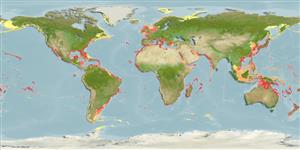Common names from other countries
Classification / Names / Names
俗名 | 同種異名 | Catalog of Fishes (gen., sp.) | ITIS | CoL | WoRMS
Environment: milieu / climate zone / depth range / distribution range
生態學
; 深度上下限 16 - 78 m (Ref. 91956).
分布
國家 | FAO區域 | 生態系 | 發現紀錄 | 簡介
Indo-Pacific, Atlantic Ocean, Mediterranean Sea and the Antarctic.
Length at first maturity / 大小 / 重量 / 年齡
Maturity: Lm ? range ? - ? cm
Life cycle and mating behavior
成熟度 | 繁殖 | 產卵場 | 卵 | 孕卵數 | 仔魚
Members of the class Polychaeta are mostly gonochoric (sexual). Mating: Females produce a pheromone attracting and signalling the males to shed sperm which in turn stimulates females to shed eggs, this behavior is known as swarming. Gametes are spawned through the metanephridia or body wall rupturing (termed as "epitoky", wherein a pelagic, reproductive individual, "epitoke", is formed from a benthic, nonreproductive individual, "atoke"). After fertilization, most eggs become planktonic; although some are retained in the worm tubes or burrowed in jelly masses attached to the tubes (egg brooders). Life Cycle: Eggs develop into trocophore larva, which later metamorph into juvenile stage (body lengthened), and later develop into adults.
主要參考資料
參考文獻 | 合作者 | 合作者
Salazar-Vallejo, S.I. and M.H. Londoño-Mesa. 2004. (Ref. 8159)
IUCN 瀕危狀態 (Ref. 130435: Version 2024-1)
CITES狀態 (Ref. 108899)
Not Evaluated
Not Evaluated
人類使用
| FishSource |
工具
更多資訊
年龄/大小
成長
長度-重量
長度-長度
型態特徵
仔魚
豐度
網路資源
Estimates based on models
Preferred temperature
(Ref.
115969): 8.5 - 27.6, mean 22.1 (based on 643 cells).
